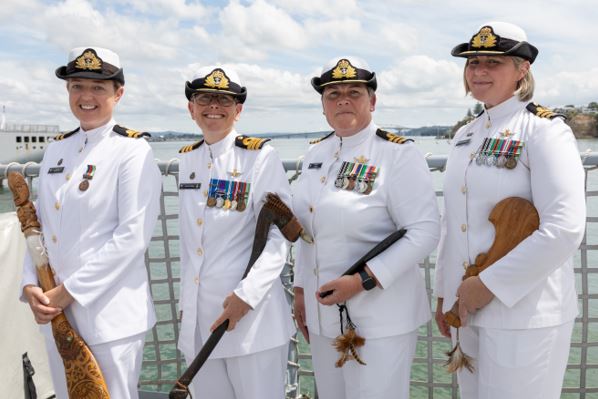- Author
- Editorial Staff
- Subjects
- None noted
- Tags
-
- RAN Ships
- None noted.
- Publication
- June 2023 edition of the Naval Historical Review (all rights reserved)
The following article stems from a press release issued by the New Zealand Department of Defence on 8 March 2023. The attached photo and explanation have been kindly supplied by the RNZN.
For the Royal New Zealand Navy, the 2023 International Women’s Day offers more reasons to celebrate than most. It coincides not only with the highest percentage ever of women in the RNZN (27.4%) but the largest number of women taking command of RNZN ships and shore units, with four in command of ships and three in command of shore units.
The photograph shows four proud commanding officers of HMNZ Ships Taupo, Manawanui, Canterbury and Te Kaha. The items carried by the Commanding Officers are the symbols of command for each of the ships. At the Change of Command ceremony, the symbol of command is passed from the outgoing Commanding Officer with the words ‘You have the ship’ to the incoming Commanding Officer who says, ‘I have the ship’. The symbols of command reside in their ships.
HMNZS Te Kaha is unique in that it has male and female symbols of command. The male wahaika, Te Kaha Nui A Tiki, usually goes to sea while the female, Hine Tai Rongo Matau, remains on shore at the Navy Marae, Te Taua Moana. However, for the first time, Hine Tai Rongo Matau will go to sea with CMDR Jameson, and Te Kaha Nui A Tiki will stay at home.
For the Chief of Navy, Rear Admiral David Proctor, all of these numbers are significant milestones. ‘International Women’s Day is a time to celebrate the diversity of our personnel and recognise the value women bring to our organisation,’ he said. ‘But we also need to walk the walk and demonstrate that women have just as much opportunity to succeed as men. Having wāhine (women) as commanding officers on more than 60% of our ships, as well as heading up shore units and other important portfolios, is a realisation of that goal.’
This is a sea change from the early days of the history of the RNZN. Despite the fact that women were first approved by the War Cabinet to join the RNZN in 1942, it took 44 years for a pilot program to allow women to go to sea in non-combatant vessels.
This program was a success and in 1989 all women joining the Navy were required to serve at sea – and from 1993 they could serve on frigates.
Since then, there has been a steady increase in the number of women joining the Navy. The reasons they do are exactly the same as their male counterparts – to learn a trade, to make a difference, to see the world, to experience things others never will and to make life-long friends.

Captain Maxine Lawes, who joined the RNZN in 1985, notes the change that has occurred in Navy culture over the years – particularly with the focus on diversity, equity and respect for personnel. ‘Our Navy had to adapt to a changing world,’ she said. ‘It wasn’t easy initially but nothing worth doing is. I now look at the confident, well-supported, motivated and highly trained women in our Navy and feel enormously proud that they don’t just serve in the Navy, but they thrive in it and are in command of it.’




